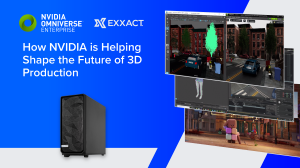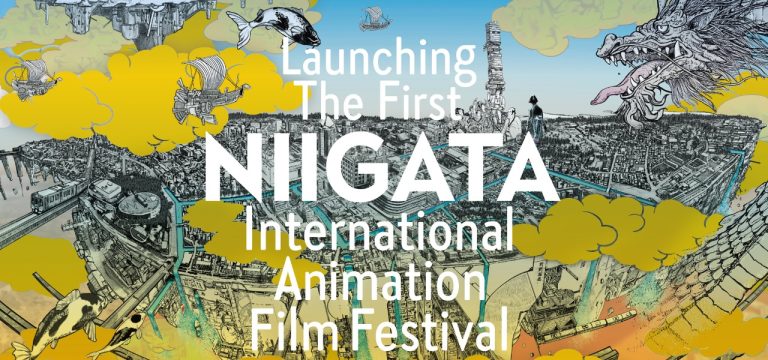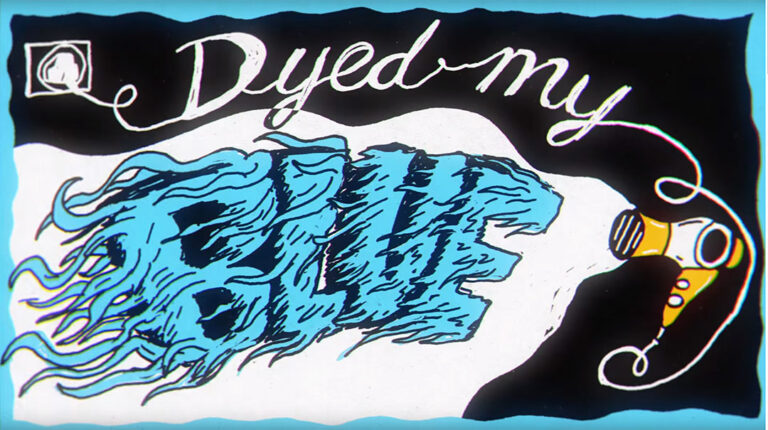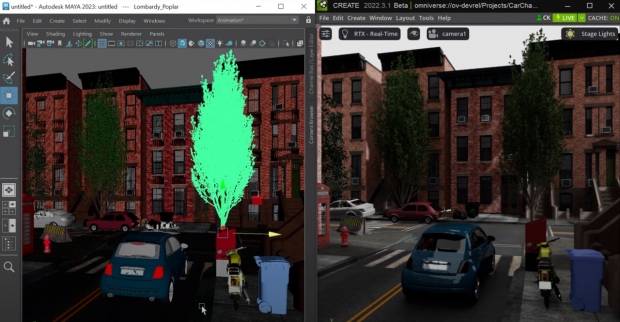
Omniverse allows project teams to collaborate – and iterate – in real-time. For example, a modeler can use Autodesk Maya to model a bar in a kitchen. A layout artist can place objects around the scene. With Unreal Engine, a texture painter can paint the back wall with Substance Painter. Each update merges into the scene in real-time through path trace rendering. This complete scene and the components within can then be viewed in a single environment by the team, or a client reviewing as an example.
Harnessing Omniverse’s strength of full fidelity visualization, essential creative efforts like previsualization can enable artists – and project decision-makers – to review and make modifications to scenes not only in real-time, but with much more fully realized lighting and rendering. This allows artists to review their work in context before they submit to render, or for review.
Omniverse also allows developers and technical artists and directors to build their own pipeline tools in a supported environment, with access to templates to help them get started for tools such as custom viewports and 3D turntables.
Kerris also noted that with NVIDIA Omniverse Cloud, an infrastructure-as-a-service that connects Omniverse applications running in the cloud, on edge devices, or on-premises, artists and creative teams can design, review, iterate, and distribute their work from anywhere. “The computer of Omniverse is everywhere, like the infrastructure of the internet,” Kerris said. “You have NVIDIA RTX PCs for creators, designers, and engineers. You have dedicated hardware like NVIDIA OVX to host client connections to Nucleus run graphics, physics, and virtual world simulations. We have NVIDIA HGX for AI workloads. We have NVIDIA Graphics Delivery Network, built through GeForce NOW, that provides low latency streaming of interactive 3D graphics experiences to edge devices. It’s available in a hundred regions. Omniverse Cloud will cover the entire globe, delivering the ability to design, build, publish, and experience 3D workflows and applications like never before.”
“M&E is going through rapid change, and demand for high-quality content is higher than ever,” says Exxact Marketing Manager Khang Pham. “Workstations powered by NVIDIA RTX GPU and running Omniverse Enterprise let studios maximize productivity, enhance communication, and boost creativity, while collaborating on the same 3D scenes from anywhere. With NVIDIA Omniverse Enterprise, the possibilities are endless for creativity.”
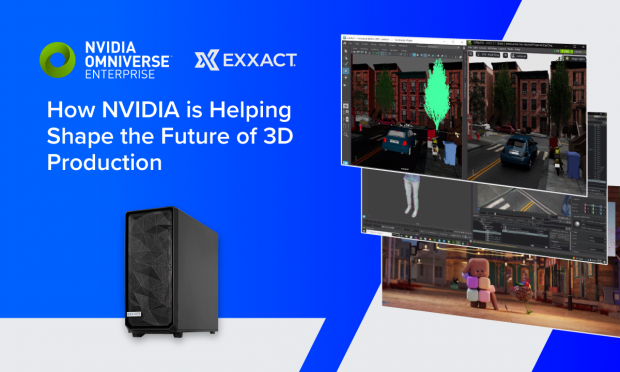
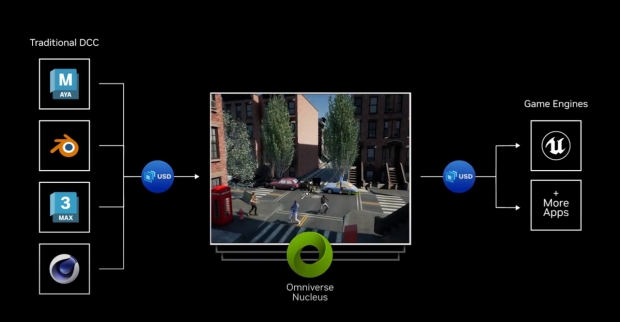
Click here for more information on NVIDIA and Exxact’s Omniverse Enterprise hardware, software, service, and support offerings.
Noting that the metaverse requires new technologies, as well as new open standards to allow data communication and visualization – so developers and enterprises can create 3D internet connections and applications – Kerris explained that at the core of this 3D standard is Universal Scene Description (USD). Which also lies at the core of Omniverse.
To better illustrate Kerris’ breakdown, in this brand-new “NVIDIA Omniverse for Previsualization” video, see how artists can build and refine previsualizations while planning shots and sequences at full fidelity, allowing for better creative decision making and helping deliver content closer to the director’s vision.
Omniverse is rooted in the metaverse, that often ambiguously defined, amorphous digital “thing” that permeates so much discussion today about the future of the internet and the billions being spent on its development. But along with its growth in industries such as automotive design and robotics, Omniverse continues to expand its reach into Media & Entertainment. Which is where Richard Kerris, VP of the Omniverse development platform and general manager for M&E at NVIDIA, hangs his hat, sharing with us a simple, clear breakdown that helps explain Omniverse’s place within the content creation world.
He continued, “In another example, for a visual effects design pipeline, [there are] multiple software products, multiple disciplines being used and lots of data being carried throughout the whole pipeline. The same pipeline used in an Omniverse scenario allows for everything to be centralized via the Nucleus Server. Nucleus is managing the assets and managing changes along the pipeline. So, you can remove the cumbersome import, export, import, export of your data along the process, simplifying a very complex pipeline, but also making it much more flexible. Another thing that Omniverse brings for workflows is the ability to work in real-time with a much higher degree of visual quality than in the past.”
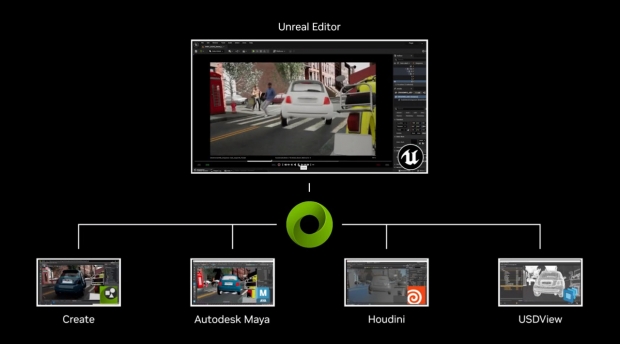
“Artists connect the tools to the Omniverse platform and work together in real-time,” Kerris shared. “It allows them to work independently and contribute collaboratively whether across the room or across the globe.”
It is important to understand that Omniverse is a platform that extends and enhances existing workflows rather than plowing over or replacing them. An expanding set of Omniverse connections via USD makes a lot of this possible, aggregating project data, and connecting tools and technologies already in place at studios. These live links between content creation tools in an interactive, ray-traced, simulated workspace empower design innovation like never before. Complex, physically accurate worlds can be created using the latest NVIDIA simulation and AI technologies powered in real-time with state-of-the-art, multi-GPU ray tracing and path tracing – and fast GPU rendering using NVIDIA RTX™ – on USD content.
Companies like DNEG, MR Factory, Ars Thanea and Moonshine Animation have used Omniverse Enterprise on various projects, such as the creation of massive, photorealistic virtual worlds requiring geographically distributed artists utilizing iterative, non-linear workflows, accessing changes in real-time using tools like Autodesk Maya and Unreal Engine.
“Omniverse is like nothing ever built,” Kerris explained. “Omniverse is a platform for connecting, building, and operating metaverse applications. Omniverse is a real-time, large-scale 3D database, a computing platform that enables 3D artists and teams to better collaborate and build or modify existing 3D pipelines and to operate virtual world simulations. Companies can write applications and services on Omniverse, and many are.”
And one of NVIDIA’s leading channel partners, Exxact Corporation, offers an optimized array of workstations and servers, including Omniverse Development systems, running NVIDIA RTX A6000 or A40 GPUs, that will support the most robust Omniverse Enterprise platform setup. Supporting companies with cutting edge technology since 1992, Exxact understands the needs of high-performance computer users.
[embedded content]
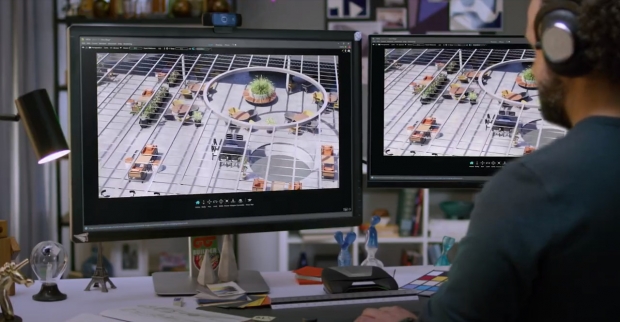
“So, what is the metaverse?” he asked the audience at the recent VIEW Conference in Turin. “In the simplest terms, it’s the 3D evolution of the internet. Until now, the internet was about cloud services connected to applications that are often enjoyed on mobile devices. The metaverse is the internet in 3D, a network of connected, persistent virtual worlds. The metaverse will extend 2D webpages into 3D spaces and worlds.”
Dan Sarto is Publisher and Editor-in-Chief of Animation World Network.


As NVIDIA Omniverse gains momentum, part of the challenge of helping the animation and VFX industries learn more about the cutting-edge, real-time, collaborative simulation platform – and its growing user base – is providing an overall perspective of its functionality, use, and benefits.
